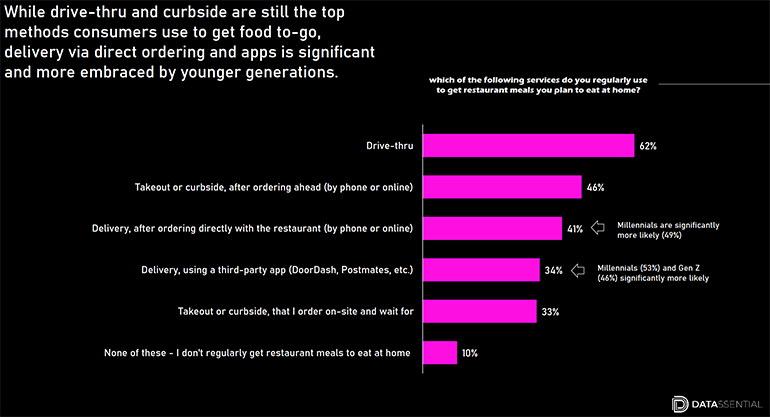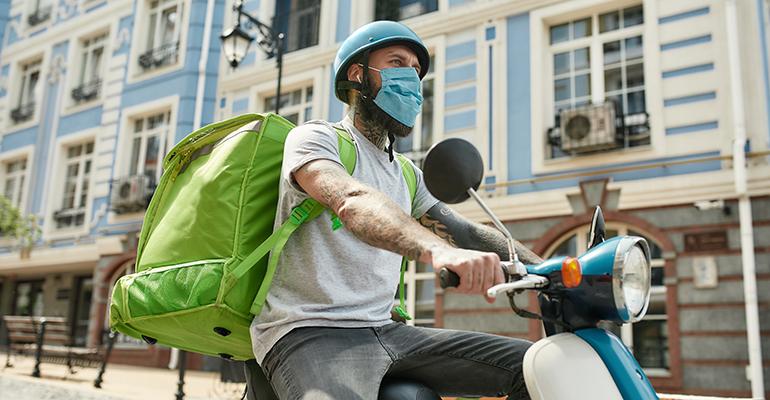Restaurant operators say the year of pandemic-related shutdowns has changed habits and preferences. And those changing consumer trends are reshaping the industry, from the way restaurants operate, to their dependence on off-premise and the design of brick-and-mortar locations. As the COVID vaccine reaches more people and the economy settles into a new post-pandemic sense of normalcy, this is part of a three-part series looking at how restaurants are adapting for the new consumer.
Before March 2020, certain demographics — Millennials and Gen Z — were more likely to swipe and scroll through their third-party delivery apps on their phone, while other demographics were more likely to prefer dining in person or picking up the phone to place a takeout order every once in a while. But the arrival of the COVID-19 pandemic became the great off-premise equalizer.
Now, 53% of adults say purchasing takeout or delivery food is “essential to the way they live,” and 68% of customers say they are more likely to purchase takeout or delivery food than they were before the pandemic, according to data from the National Restaurant Association’s State of the Industry report released in January.
And restaurants are responding to that demand: 46% of family-dining and fine-dining restaurants said they added delivery options between March and December, along with 44% of casual-dining and fast-casual restaurants.
“Consumers are more receptive to how they pay for restaurant meals now, in terms of technology,” said Hudson Riehle, the association’s senior vice president, research and knowledge group. “For operators, the ability to execute off-premise definitely has the tenacity to continue forward.”
But not all off-premise opportunities are created equal. According to Datassential, drive-thru and takeout or curbside pickup has been the top off-premise restaurant experience for consumers during the pandemic, with 62% of surveyed consumers using the drive-thru for meals eaten at home, and 46% using takeout.
Despite the jump in popularity during the pandemic, delivery comes in third: with 41% of customers ordering delivery directly from the restaurant and 34% using a third-party app for delivery.
App appeal
Even though Datassential’s research showed drive-thru and takeout as the more popular options among consumers, don’t discount the growth of delivery app literacy, Datassential’s group manager Mark Brandau said.
“The growth in delivery has been pretty consistent: it’s one of those things that once people try it, they tend to stick with it,” Brandau said. “There might have been some ebbs and flows over the summer with outdoor dining, but delivery is a steady option because we always end up back home. If I need to feed my family I don’t want to have to go back out.”
 During the pandemic, traditional sit-down dining categories like casual- and family-dining saw their off-premise sales grow significantly, with 69% of family-dining and 70% of casual-dining restaurants reporting off-premise as a larger portion of their sales during the pandemic, according to the National Restaurant Association report.
During the pandemic, traditional sit-down dining categories like casual- and family-dining saw their off-premise sales grow significantly, with 69% of family-dining and 70% of casual-dining restaurants reporting off-premise as a larger portion of their sales during the pandemic, according to the National Restaurant Association report.
Community and connections
But is the demand for off-premise options (and smaller push for delivery) a temporary trend that will snap back as soon as customers are able to safely return to restaurants?
The answer is complicated. The National Restaurant Association reported the phenomenon of pent-up demand for on-premise dining during the pandemic. According to their State of the Industry report, 84% of customers said in April that they’re not eating in restaurants as often as they’d like. And although that number diminished over time, the pent-up demand for on-premises dining reached 67% by December.
The question remains whether consumers will continue to demand digital convenience or whether they will be putting more value on the experience of eating out.
Datassential’s Brandau thinks consumers will want a little bit of both:
“Home and work have been our only places for so long, that we just want a third place back,” Brandau said. “I think the demand for dining out will come back, and in terms of using these convenient options, it will depend on what the customer needs occasion by occasion. Soon, your average restaurant will be better prepared to handle those different consumer need states than they were before and during the pandemic.”
Keeping the customer satisfied
The other major consideration when customers balance cravings for delivery versus in-store dining will be quality of experience.
According to September 2020 data from Datassential, customers reported a mixed experience with food delivery, with 73% saying delivery is too expensive once you factor in fees and tips, and only 59% said they would continue using delivery apps in the future after the pandemic ends.
Research from data and insights company Black Box Intelligence came to similar conclusions: as of December, consumer sentiment of food obtained from limited-service brands through delivery were 23% more negative than positive. In contrast, dine-in experiences received 14% more positive mentions than negative. Full-service brands received a negative net consumer sentiment of -6% for delivery and +56% for dine-in experiences.
“When people go to restaurants, they tend to be more satisfied with their experience,” said Victor Fernandez, vice president of Black Box Intelligence. “The compounded problems with takeout are if the order is not right, takes too long, etc. and you don’t know who the responsible party is [the restaurant or delivery service]. So that means we have a higher adoption rate but with lower guest sentiment.”
Contact Joanna Fantozzi at [email protected]





